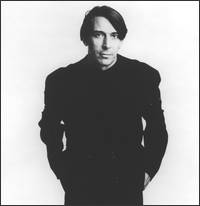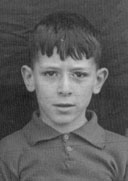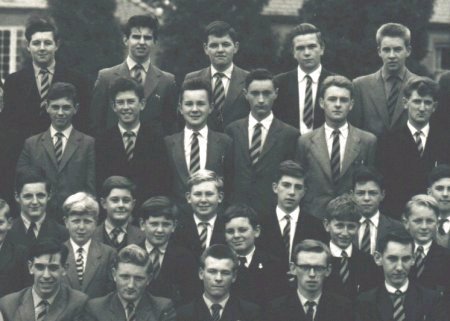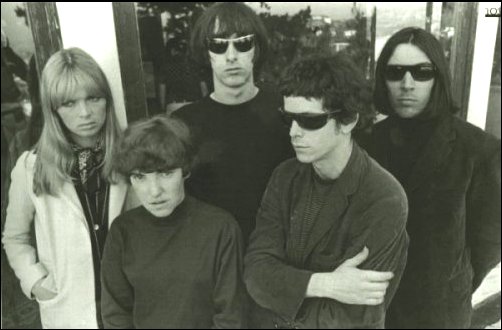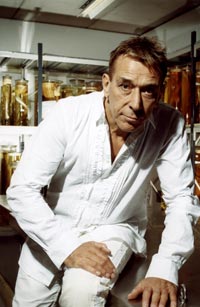John Cale was born in Garnant in the Amman Valley and went to Amman Valley Grammar School in Ammanford. He is the valley's most famous (only?) international rock musician, playing with the cult rock band Velvet Underground in New York in the mid 1960s. The best known member of the band was their singer Lou Reed (Take a walk on the wild side).
Velvet Underground are now seen as a punk band ten years before punk officially arrived in the 1970s. At the time, however, they were regarded as an avant-garde group, ie, experimental, modern, new, often deliberately outrageous, controversial and shocking. Their manager was Andy Warhol.
In 1999 John Cale published his autobiography called "What's Welsh for Zen?" The opening paragraphs describe his Garnant upbringing in these words:
"I was born on 9 March 1942 in Garnant, between Swansea and Carmarthen, South Wales. Some 3,000 miles away in Brooklyn, New York, Louis Reed had been born one week earlier, on the 2nd.
.....I always knew he had an edge on me!
.... My only memory of the Second World War is my mother taking me into our beautiful little garden and the two of us staring at a giant red glow over Swansea. Later, I remember hopping up and down with two other kids singing, 'We won! We won! We won!' Then the United Kingdom fell into a gloomy and damp depression. This was the first stage of the Cold War. My parents and uncles, aunts, cousins, grandparents, the lot, suffered from coupon rationing and black-market vice, which kept the poor downtrodden in Britain for the next twenty years.
.... I spent my first eighteen years in a rural mining village near the banks of the Amman River in the foothills of the Brecon Beacons. This was a strange, remote, some said mystical land. It was rich in the Arthurian legends, and had retained its identity through centuries. It was one of the few parts of Britain that neither the Romans nor the Normans conquered. Our part of Wales was cut off from the body of the country by natural defensive barriers of rivers and mountains. When the Romans came, we waited for them out in the hills. When the English came, we withdrew deeper into the caves. During the reign of Henry IV, Owen Glendower became a lifelong scourge from the stronghold of the mountains. Through these wars one can chart the growth of the Welsh nation. Folk song and poetry guarded our legends through wars, plagues and religious bonfires fuelled by the bodies of those accused of witchcraft, mostly women. Our language, our literature and our music gave us a cherished sense of nationhood.
.... English has always been my second language. But my father spoke no Welsh since he was from the Llandaff area of Wales, on the English border. I learned English in school when I was seven years old. So how did my father and I communicate during those early, formative years? There is a parallel here between language and music. The awkwardness I later felt when writing songs, I used to think of as a concomitant of my belief in the strength of instrumental music. It may also have had something to do with an incomplete sense of language. Yet music is a language as much as English and Welsh, and transcended them both in the ease with which I could use it to communicate. It was a comfort I found nowhere else.
.... The strongest influence on us was our preachers. They were not dry, ascetic scholars, but bold men who dominated their flocks with the fear of the wrath of the Lord. Farmers, carpenters, stonemasons, they performed from their pulpits with a Bible in one hand and a warning finger wagging heavenwards on the other, threatening fiery damnation to those who flirted with the perils of flesh and alcohol. Our preachers still appear at high days and holidays, and their devastating sermons have the same life-and-death intensity as American black gospel preaching.
.... Our preachers were also teachers who believed that education was an end in itself. The part of Wales I grew up in had long had high educational standards, thanks largely to the great Griffith Jones who established a network of village schools in the nineteenth century. Many teachers were also hymn writers, harpists and musicians of one kind or another." [Note: Griffith Jones (1683 - 1761) established his schools in the eighteenth, not the nineteenth, century. To read more about this important period in the history of Welsh education, click HERE.]Interestingly, in the above memoir John Cale seems to be remembering one of the 46 bombing raids that Swansea suffered during the Second World War, resulting in a total of 382 deaths, several hundred more injured, and Swansea town centre reduced to a pile of smouldering rubble:
"My only memory of the Second World War is my mother taking me into our beautiful little garden and the two of us staring at a giant red glow over Swansea."
The young John Cale The last air raid on Swanea was on Tuesday 16th February 1943 when 32 high explosive bombs and countless incendiaries dropped on Neath Road, Hafod; St. Thomas and Brynmill. There were 34 deaths, 110 casualties and severe structural damage, and no doubt the red skies above Swansea would have been visible for miles around, including Amman Valley gardens fifteen miles north across the Betws mountain. John Cale was just eleven months old at the time, though, so perhaps he's remembering a later event, a sunset maybe, and mixing this up with stories of the war heard while he was growing up. Memory seldom, if ever, works in a simple way, and a single memory can turn out to be a composite of more than one recollections, and is no less true for that. (The worse air raid on Swansea was the "three nights' blitz" from 19-21 February 1941. Over these three nights of intensive bombing, which lasted a total of 13 hours and 48 minutes, Swansea town centre was almost completely obliterated by the 896 high explosive bombs employed by the Luftwaffe. A total of 397 casualties and 230 deaths were reported. The skies above Swansea on those three nights were certainly visible - and audible - for many miles around.)
For the curious, a website listing all the 2nd World War bombing raids on Swansea, with casualties, can be found by clisking on the Explore Gower website.
But not all Cale's memories of the Amman Valley are bathed in the rosy glow of nostalgia as described in his autobiography. In a recent interview with American magazine 'The Onion' he talked about his work and early influences, including the difficulties he encountered in trying to appreciate 'avant-garde' ideas during his formative years in Wales. In the interview he said of that time: "I was from this really repressed Welsh village, where I'd lived under the gun of religion and language. You try and become a composer in Europe in the '50s and '60s, and more than anything, you have to prove your social value ..."
The first chapter of John Cale's autobiography describes his life and upbringing in Garnant and Ammanford up to his departure to University in London in 1960. Thereafter it moves on to London and New York.
In the 2010 Queen's honours list John Cale was awarded the OBE (Officer in The Most Excellent Order of the British Empire) for his services to music and the arts. The OBE is conferred by the Queen in person at Buckingham Palace, who pins a medal on the recipient's chest during the investiture ceremony. John Cale now joins such luminaries as Sir Mick Jagger, Sir Tom Jones and others who have made the journey from wild men of rock to thoroughly safe establishment figures.
John Cale's career is summarized in the following article from the Rolling Stone rock magazine:
Perhaps few musicians deserve the title "artist" as much as composer/producer John Cale, who despite escaping mainstream attention has been a major influence on modern-day music. His 30-plus year career as a performer spans everything from rock to classical, while as a producer he has worked with such luminaries as Patti Smith, the Stooges, and Siouxie and the Banshees.
.... John Cale was born on March 9, 1942 into a South Wales working-class family and grew up playing the piano and viola. While studying experimental music at London University in the early '60s, he met American classical composer Aaron Copeland, who got Cale a scholarship to study with the Boston University Orchestra. In the fall of 1963 Cale relocated to New York and began performing in various avante garde music projects before hooking up with vocalist/guitarist Lou Reed, with whom he founded the legendary rock band the Velvet Underground in early 1965. Playing bass, viola, and keyboards, Cale was largely responsible for the band's droning sound, while Reed wrote the lyrics; soon the two began to argue over the band's direction, and Cale left the group shortly after they recorded White Light/White Heat in 1968. Cale began a career in production, working with the Stooges and former Velvet Underground collaborator Nico, simultaneously preparing material for a solo career.
The Velvet Underground in 1966: Left to Right – Nico, Maureen Tucker, Sterling Morrison, Lou Reed, John Cale. .... Cale began his solo career in 1970 with Vintage Violence, a rather traditional, introspective singer-songwriter album. His next work, 1971's Church of Anthrax, was an abstract, almost ambient collaboration with minimalist composer Terry Riley that was mostly instrumental. Moving to Reprise Records, Cale recorded the symphonic 1972 album Academy in Peril, followed in 1973 with the haunting melodic pop album Paris 1919, considered one of his best. Meanwhile Cale continued working for Warner/Reprise as an in-house producer and A&R man, working with, among others, Jonathan Richman and the Modern Lovers and pop singer Jennifer Warnes.
.... In 1974 Cale signed a multi-album deal with Britain's Island Records, who released his next three, more rock-oriented albums: Fear (1974), Slow Dazzle (1975) and Helen of Troy (1975). These albums were not distributed well in the U.S., though tracks were released on the 1977 compilation Guts. Cale's live shows became increasingly wild; at one performance he killed a chicken on stage, causing members of his band to quit. During this period Cale continued moonlighting as an independent producer, working with Patti Smith on her acclaimed debut album Horses, the new wave pop group Squeeze, and even the British punk band Sham 69. He also performed with fellow producer/composer Brian Eno on a few of Eno's early recordings.
....Cale's next studio album was the 1981 political pop record Honi Soit, followed a year later by the dark album Music for a New Society. 1984's Caribbean Sunset was recorded with a new backup band, and was poppy and spontaneous. Artificial Intelligence, released in 1985, was a keyboard-oriented rock album co-written with rock journalist Larry Sloman. After the birth of his daughter Eden that same year, Cale took some time off from music to spend time with his family.
..... Switching to Brian Eno's label, Opel, Cale returned to music in 1989 with Words for the Dying, which featured Dylan Thomas poems read over symphonic music. Cale directly collaborated with Eno on 1990's Wrong Way Up, an accessible album considered to be some of their best work. Also that year Cale put aside his differences with Lou Reed, coming together with his former bandmate to record Songs for Drella, a tribute to Andy Warhol, who gave Velvet Underground its start. This collaboration led to a failed 1993 Velvet Underground reunion tour, which only played a few dates in Europe before ending due to old differences.
.... Recently Cale has recorded soundtracks for two French art films. His most recent studio albums, 1992's acoustic Fragments of a Rainy Season and 1996's Walking on Locusts, are less experimental than his past work."Here is an article printed in 2002 from the first edition of Mynydd Du Flyer, a free monthly magazine circulating in the Mynydd Du (Black Mountain) area of Llandeilo, Ammanford and Ystradgynlais:
John Cale in 2005 Trying to categorise Cale's music has always been tricky, encompassing as it does so many diverse musical styles. Not really a rocker nor a full on avante gardiste, much of what he produces falls between the two headings. He draws heavily on his early classical training; he was touring the country with the National Youth Orchestra of Wales from his early teens, while still listening to the burgeoning cult of rock and roll in his bedroom at night. Elvis was a favourite and Heartbreak Hotel still features in his live set. He is perhaps most famous as co-founder of the Velvet Underground yet this achievement is far from the be all and end all of his creative career.
....At the age of thirteen he composed his first serious work and it was judged sufficiently important to warrant a visit from the BBC to record it. On the day of the recording the sound equipment turned up but the music manuscript had gone missing. Cale later said that the experience of having to improvise "Tocatta in the style of Khachaturian" had been a seminal moment which had creatively liberated him. It was two and a half minutes that had changed his life.
.... How it changed is charted in Cale's vast catalogue of music and in his wonderful autobiography "What's Welsh for Zen?" Here the artist details his relationships with-both of his parents as well as his wider family and reveals in photographs and words that are both humorous and sad by turns, what it was like to grow up in such a community.
....There can be no doubt that the Cale family were exceptional. Although John's father worked in the local mine, the Gelly Ceidrim, and appears to have been brutalised to some extent by the experience, his mother had pursued a career in teaching and was widely recognised for her pioneering techniques. When she retired from her profession to get married, John, as the only child became the focus of all of her creative energy. "Don't ever tell me you can't do something" she once rebuked her young son.
.... John Cale always sensed that his future lay in America. Evenings were spent fantasising of a time when he could join the ranks of the beat poets and avante garde composers on Manhattan's Lower East side. His eventual move to college in London was only seen as a stepping stone towards his ultimate goal of living and working in America. It was also a sort of compromise made to placate his mother who was still funding his education. She wanted him to become a doctor or a lawyer.
.... At college he forged an alliance with the English radical and founder member of the Revolutionary Communist Party, Cornelius Cardew. He introduced the young Welshman to people like John Cage and La Monte Young who were involved with the Fluxus art movement in London and New York. This contact with the flourishing Avante Garde of the early sixties sustained him throughout his difficult time at Goldsmiths where he was studying musicology.
.... Picking only the elements that he found to be relevant to him personally, Cale convinced most of his tutors to allow him to skip a lot of the required course work to concentrate solely on music. He wanted to be a living composer and not a "cataloguer of the dead." He was hardly interested in his contemporaries either. Instead he sought out older musicians who could teach him how to play the sort of music he was interested in. His final presentation to be performed in front of the whole school, the bemused assembled parents and the faculty, was an incendiary piece of new music by his mentor, La Monte Young, called "A X for Henry Flynt." It involved a funeral cortege of mourners banging dustbin lids and playing the piano part with his elbows.
.... He immediately left for the States to take up his Leonard Bernstein scholarship at the Berkshire Music Center, Tanglewood, Boston. Here he worked with Aaron Copeland and John Cage taking part in a relay performance of the 80 second piano piece "Vexations" by Eric Satie played 240 times over 18 hours. The audience were given an increasing percentage of their entrance money back the longer they stuck it out and received a total refund for still being there at the end.
.... By 1963 he reached the town of his dreams, New York. It wasn't long before he met and teamed up with Lou Reed to form The Velvet Underground, catapulting both of them to prominence. The band were soon picked up by Andy Warhol who used them to create his multi-media events where they played to a simultaneously projected backdrop of films and images and strobe effect lighting. His input on the Velvet Underground recordings is distinctive and undeniable, but full credit was never really given. John, perhaps naively, assumed that Lou Reed would acknowledge his contributions to their combined efforts. Instead he was sidelined by the self proclaimed leader of the band and eventually sacked after they made just two records.
.... His solo career kicked off in 1970 and was heralded by a spate of album releases. "Vintage Violence" was followed the next year by "Church of Anthrax, "a mostly instrumental, ambient sounding collaboration with minimalist composer Terry Riley. This was followed in '72 by the symphonic "Academy in Peril" and the melodic pop album "Paris 1919" the year after. The latter has been much acclaimed. Around this time his live performances were becoming increasingly wild and famously culminated in the dismembering of a chicken on stage, an act which some fellow band members judged a step too far, prompting them to quit. By now he had signed with the British Label, Island Records, and released the albums "Fear", "Slow Dazzle" and "Helen of Troy." His prolific output continues to this day with a 1990 high point "Songs for Drella' a tribute to old friend and mentor Andy Warhol and co-written with Lou Reed.
....In 1997 John Cale returned to Garnant as part of a documentary the BBC were making about his life. "Going home," he said "always gives me a new lease on life; I am fascinated by the emotional curve of my journey from Wales to New York and back again. When I return to the Amman Valley it as if to the bosom of a friend. That friend floats in the language and seduces me with each translation."SOME LINKS
A website devoted to anything and everything relating to John Cale, including albums, forthcoming tours, quotations, and numerous photographs from all stages of his life, can be found by clicking on: http://www.xs4all.nl/~werksman/cale/index.html. The front page of this website displays his OBE medal for all to see.
[Note: Websites tend to be pretty short lived so it's best to type the words "John Cale" into a search engine such as www.google.com to find what sites are currently available].
Date this page last updated: October 1, 2010 s
